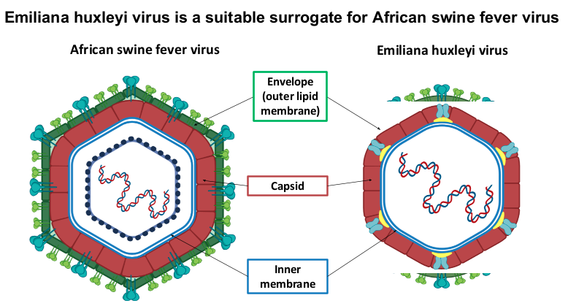A team of researchers, led by University of Minnesota Professor Jerry Shurson, developed and validated a new surrogate virus assay for African Swine Fever virus (ASFV). This surrogate virus assay will allow researchers to better understand how ASFV survives in feed ingredients and to explore strategies to inactivate the virus and decontaminate facilities in the event of a potential ASFV contamination.
“This is a major breakthrough to reach our goal of accelerating research for understanding the survival of ASFV in various feed ingredients and complete feeds, as well as evaluating the effectiveness of various mitigation strategies to inactivate ASFV in feed and decontamination strategies for feed mills if they were to become contaminated with ASFV,” says Shurson.
Shurson and the African Swine Fever Response Team spent three years developing and evaluating the new assay, which uses the surrogate virus Emiliania huxleyi (EhV). The team has found that EhV has remarkably similar structural and thermal stability to African Swine Fever virus. The EhV is also a safe surrogate for ASFV because it only infects marine algae but not plants, animals, or humans.
Due to the highly infectious and devastating nature of ASFV, the team had to work through numerous regulatory requirements to get approved for experimental use of ASFV to validate the surrogate virus assay. The USDA, FDA, and the MN Department of Agriculture have been key collaborators throughout this process, along with research funding support provided by the United Soybean Board and several other feed industry partners.
Once all of the regulatory requirements were met, the first validation experiments were conducted in August 2022 comparing ASFV and EhV. The results showed that both viruses behaved similarly when exposed to temperatures up to 100°C.
"Now that we have validated this surrogate EhV assay, we are discovering that the time, temperature, and chemical mitigation conditions needed to destroy these mega viruses so that they are no longer infective is more difficult than results from previous studies have led us to believe,” comments Shurson.
Shurson and his team continue to study the surrogate EhV assay to learn more about the resiliency of African Swine Fever and Emiliania huxleyi viruses. Their findings will help to prevent ASFV infections in the United States and across the world.
About African Swine Fever virus
African Swine Fever is a major devastating global swine disease that causes nearly 100% mortality and continues to spread to many countries around the world. The virus was discovered in the Dominican Republic and Haiti in 2021 but it has not yet reached North America.
The ASFV only affects wild boars, feral pigs, and domestic swine, is not a threat to other animals or humans, and pork is safe to eat. However, because there is no effective vaccine or treatment, biosecurity to prevent ASFV contamination in feed, and use of effective thermal and chemical mitigation treatments for feed suspected of virus contamination have become extremely important for the U.S. pork and feed industry.
In 2019, more than half of the pigs in China (about 25% of all of the pigs in the world) were infected and lost because of this virus, which has had major effects on global meat and feed supply chains and prices. African Swine Fever virus is also causing devastating losses in major pork production countries in Eastern Europe and has continued to spread to Germany and Italy.
This work is supported by the USDA National Institute of Food and Agriculture. Primary research funding support provided by the United Soybean Board and several other feed industry partners.
